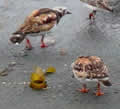2016/08 Newf'land trip - Portugal Cove South |
|||||
We set off further south down the coast road through a succession of small villages squeezed between road and coast but then there was a big change beyond Cappahayden, where we swung away from the coast into barrens country. Now we saw vast open areas of grass and rocks with straggly spruce trees. This is the Avalon Wilderness Reserve, home to moose and caribou. We saw a couple of cow moose really close to the road but the rain had returned so we have no pictures.
We stopped in Portugal Cove South at the Edge of Avalon interpretive centre, eager to get out of the rain. Yes, the Portuguese got into the fishing act here too. We were mainly there to book up for the guided tour out to Mistaken Point, as recommended a week earlier by the ranger at Green Point. However, the first available tour was a week away. They said the publicity surrounding their recent elevation to UNESCO World Heritage status had greatly increased the number of visitors. The tour is on foot, a long rocky hike crossing several streams and they remarked that today’s tour might be grueling for those lucky enough to go.
The Mistaken name comes from all those skippers who mistook the point for a nearby cape, their signal to turn into a safe harbour. Many of them ended up on the rocks.
In modern time the fuss is about the fossils found there. Back 580 million years ago a volcanic ash deposit over the ocean covered and preserved the outlines of ancient life on the ocean floor. This is the oldest complex life form known, living long before animals had the shells and skeletons to make fossils.  The ocean floor has been uplifted and tilted by the subsequent continental collision so that the outlines and shapes can be seen in the cliffs. This is the only place in the world that has as many visible varieties of these Ediacaran life forms.
The ocean floor has been uplifted and tilted by the subsequent continental collision so that the outlines and shapes can be seen in the cliffs. This is the only place in the world that has as many visible varieties of these Ediacaran life forms.
We toured the museum, having to be content with looking at reproductions of the rock faces and the animals’ outlines. Outside, the weather was still foul and we retreated to a park we’d passed on our way.
Chance Cove is at the end of a narrow track down to the coast. It’s an unmanned provincial park with free camping. It turned out to have a parking area tucked into a valley behind coastal cliffs. The parking area was almost full of unattended trailers, but we found an empty slot. We weren’t on our own but only heard other people; we never saw anyone. We had a fine sunset between rain showers.
![]() Friday August 19th
Friday August 19th
We had to admit that this was the turnaround point of our trip. From now on we’d be traveling home. We had to be at Port aux Basques, some 600 miles away, by Monday morning to catch the ferry to Nova Scotia. From there we’d have over 2000 miles to get to Minnesota, probably 2500 as we were planning a southerly route, avoiding the rust belt. We hoped to be in Minnesota before the Labour Day ![]() weekend about two weeks hence. This didn’t mean we wouldn’t have time to see anything new but we’d have pay attention to the schedule. For now we were a day ahead, as we were not doing the Mistaken Point hike.
weekend about two weeks hence. This didn’t mean we wouldn’t have time to see anything new but we’d have pay attention to the schedule. For now we were a day ahead, as we were not doing the Mistaken Point hike.

 We heard a strange howling during the night, almost like wolves, but they are extinct in Newfoundland. We walked down to the cliffs on a calm and cloudy morning and found our “wolves”, about a dozen seals fishing in the shallows below us. There were also birds we didn’t recognize, possibly turnstones, and a yellowlegs. All were beyond our cameras’ limits but I’ve included the pictures anyway, the best we could do. The seal picture is a composite; they weren’t that close together.
We heard a strange howling during the night, almost like wolves, but they are extinct in Newfoundland. We walked down to the cliffs on a calm and cloudy morning and found our “wolves”, about a dozen seals fishing in the shallows below us. There were also birds we didn’t recognize, possibly turnstones, and a yellowlegs. All were beyond our cameras’ limits but I’ve included the pictures anyway, the best we could do. The seal picture is a composite; they weren’t that close together.